Immunity to infections. - PowerPoint PPT Presentation
Title:
Immunity to infections.
Description:
Immunity to infections. Prof. Mohamed Osman Gad El Rab. College of Medicine& KKUH. During the life- cycle, many antigens appear : Infection begin with mosquito bite. – PowerPoint PPT presentation
Number of Views:64
Avg rating:3.0/5.0
Title: Immunity to infections.
1
Immunity to infections.
- Prof. Mohamed Osman Gad El Rab.
- College of Medicine KKUH.
2
Classification of immunity.
- classification of acquired immunity.
- active.
passive. - natural. artificial. natural.
artificial. - infections. immuniz. Maternal
immuno - - IgG.
therapy.
Subclinical. Clinical.
Vaccines.
IgG from mother to fetus.
Ready made antibodies .
3
General features
- First encounter with any microbe ( at any
- age )
- Primary immune response.
- 4 phases
- 1. lag .( no antibodies
) - 2. log. ( antibodies
appear ) - 3. plateau.( no more
synthesis ) - 4. decline.( antibody
disappear ).
4
Primary immune response
- 1. takes a longer time ( recognition of
antigen, - differentiation proliferation of
cells ) . - 2. antibody class mainly IgM .
- 3. memory cells generated .
5
General features
- Second encounter with same microbe
- Secondary immune response
- 1.require small amount of antigen.
- 2. fast reaction ( memory cells ).
- 3. high levels of antibody ( IgG ).
6
Nature of infecting microbe determine type of
response .
- extracellular microbes .
- ( bacteria)
- Th 2 helper cells.
- antibody- mediated immunity.
7
- intracellular microbes .
- ( viruses , intracellular bacteria ,
fungi ) - Th-1 helper cells .
- cell- mediated immunity .
8
Th1 , Th2 cells down-regulate each other.
- 1. each cell type secrete different
- cytokines.
- 2. balance between Th1 Th2
- determine the clinical presentation of
- the disease .
9
The balance between TH1 TH2
is important in immunity. It
determine the clinical
presentation of the disease .
10
Many factors influence immune response to
infections
- 1. structure of the microbe antigen.
- 2. dose of infection (optimum dose, good
response). - 3. route of entry into the tissues .(
determine - site of reaction ).
- 4. host factors - genetic constitution.
- - age .
11
Immunity to bacterial infections
- extracellular.
intracellular. - protection by
- antibody- mediated cell-mediated
- immunity.
immunity.
12
Adherence
13
protective functions of antibodies
- 1. neutralizing action
- - prevent pathogens from binding to
- tissues.
- - prevent the action of toxins .
- 2. activate complement .
- 3. stimulate phagocytosis .
- 4. stimulate NK-cell-mediated killing .
14
Penetration into the host Cell
Salmonella entering epithelial cells via
invasins
Figure 15.2
15
Protective functions of antibodies.
16
microbial strategies to avoid the immune
system
- e.g. Pneumococcus.
- has large polysaccharide coat .
- can evade phagocytosis .
- Mycobacteria .
- have waxy coat secrete catalase.
- can block respiratory burst.
17
. In chronic intracellular infections e.g.
T.B. excessive CMI responses lead to
granuloma formation .
18
Granuloma formation ( T.B. )
19
Complications of immune responses .
- In some cases disease is not caused by
- the bacteria but rather by the immune
- response.
20
Endotoxins of gram ve bacteriaactivate
macrophages which releasehigh levels of
IL-1, TNF - alpha, these may cause
Septic shock .
21
- In staphylococcal food poisoning ,
- enterotoxins act as superantigens
- and cause direct massive T-cell
activation . This may cause - Toxic shock syndrome .
22
immunity to viral infections
- initially
- 1. interferon, secreted by
- - infected cells.
- - inflammatory cells.
- 2. NK- cells.
23
Antibody- mediated immunity
- Anti-viral antibodies
- 1. prevent spread during acute infection.
- 2. protect against reinfection .
24
adaptive immune mechanisms
- cell-mediated immunity .
- activation of CD8 T-cells.
- - inhibit viral replication.
- - kill infected cells .
25
Viruses can evade host defenses.
- 1. Hepatitis C virus
- overcome anti - viral effect of INFs
- blocking the action of protein kinase.
- 2.Adenoviruses CMV
- reduce surface expression of MHC-1.
26
Influenza virus .
27
(No Transcript)
28
1. Antigenic drift gradual minor change in HA
NA.
- 2. Antigenic shift
- sudden major change in HA NA .
- ( new subtype emerge )
29
(No Transcript)
30
- Immunity to parasitic infections
31
The type of the immune response
depend on the location of the
parasite in the host .
- In the blood antibodies may be effective
- In the intracellular stage CMI may be
- effective.
32
Immunity to Malaria
- Caused by genus Plasmodium.
- P.falciparum is the most virulent
prevalent. - Infect 10 of the population.
- Causes 1 2 million deaths every year.
- Have a complex life cycle .
- ( many antigens appear during infection
)
33
Life cycle of malaria
3-stages.
34
During the life- cycle, many antigensappear
- Infection begin with mosquito bite.
- Sporozoites enter the blood disappear
- within 30 min.
- Migrate to the liver after 1
week - release merozoites which infect RBCs.
35
Sporozoites stay for only 30 min. in the
blood, therefore induce a poor immune
response.
- The intracellular stage in the liver cells
- and RBC ,reduce the degree of immune
- activation generated by the pathogen.
36
Immunity to parasitic worms (helminthes)
- Helminthes are large multicellular
- organisms e.g. Schistosoma (Bilharzia ).
- Have complex life- cycle .
37
(No Transcript)
38
- Cercaria enter the blood stream and
become schistosomules which enter - capilleries.then pass to the lungs
liver. - then become adult worms.
39
Humoral immune responses to parasitesare
characterized by
- 1. elevated IgE.
- 2. blood eosinophilia .
- Eosinophils mediate ADCC to
- damage the parasite.































